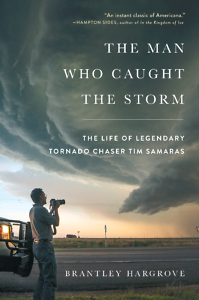The Darkness at the Door
Brantley Hargrove tells the story of a storm-chasing, tornado-catching legend
In 2003, just outside the small town of Manchester, South Dakota, Tim Samaras did something that had never been done before: he built and deployed a device that was able to withstand winds in excess of 200 miles per hour inside a category F4 tornado, one of the most destructive forces on earth. The device successfully recorded data that would advance the science of tornado prediction, increase warning times, and save lives on the ground. It was “meteorology’s equivalent to the moon landing,” writes Brantley Hargrove in The Man Who Caught the Storm. In a few historic seconds, Tim Samaras became a storm-chasing, tornado-catching legend.

A decade later, his luck ran out. Samaras, along with his twenty-four-year-old son and another team member, were caught in Oklahoma by a storm so large it comes along only once in 900 years. They were the first storm chasers ever killed by a tornado. It was a tragic end to a career as eventful as it was unlikely.
In 1993, when he first began storm-chasing in earnest, Samaras was a 35-year-old father of three who lived with his family near Denver, Colorado. A self-taught tinkerer with a knack for mechanical gadgetry, Tim worked for the Denver Research Institute, where he tested weapons systems. Mesmerized by storms from an early age, he enrolled in a six-week course in meteorology and storm-spotting sponsored by the National Weather Service.
At first he chased only nearby storms, but by the mid-1990s he was arranging his vacation days each year to coincide with tornado season in the Midwest. “Tornado Alley” stretches from Texas to the Dakotas, where warm, dry air from the Rockies collides with cooler, moist air from the Gulf of Mexico, creating massive storms known for their destructive power and dangerous unpredictability. “Chasing is prognostication and timing,” Hargrove writes. “It’s predicting where the tornado could happen, and being there at the precise moment that it does.” Samaras turned out to be a natural storm-chaser with a real knack for reading the signs.
 On average, meteorology can provide warning of an impending tornado fourteen minutes before it hits. Radar is the most accurate predictor of tornadoes, but it cannot see around obstructions or compensate for the curvature of the earth. Scientists need to know more about the pressure, humidity, and temperature inside the tornado: “There has always been a blind spot at the place we most want to see,” Hargrove writes, and the storm-chasing business is littered with once-promising research projects. Even the whimsically named Totable Tornado Observatory (TOTO, for short), a 300-pound metal drum filled with instrumentation, ultimately proved unsuccessful.
On average, meteorology can provide warning of an impending tornado fourteen minutes before it hits. Radar is the most accurate predictor of tornadoes, but it cannot see around obstructions or compensate for the curvature of the earth. Scientists need to know more about the pressure, humidity, and temperature inside the tornado: “There has always been a blind spot at the place we most want to see,” Hargrove writes, and the storm-chasing business is littered with once-promising research projects. Even the whimsically named Totable Tornado Observatory (TOTO, for short), a 300-pound metal drum filled with instrumentation, ultimately proved unsuccessful.
That was before Samaras created a short, fat, cone-shaped data-gathering device nicknamed “the turtle.” Few in the field expected an unschooled amateur to solve problems that had long stumped credentialed researchers, but Samaras embodied a unique combination of excellent storm-chasing instincts, self-taught engineering know-how—including extensive experience in controlling and measuring powerful blast waves—and a tremendous belief in himself and his ability to deliver results.
Hargrove’s tribute to this “cowboy” storm chaser is filled with lyrical descriptions of the immense power and ethereal beauty of the storms Samaras chased. The Man Who Caught the Storm presents the science in terms a lay reader can easily understand, and Hargrove captures the emotional power of the story in a way that makes the book nearly impossible to put down.
Despite its tragic ending, this story is ultimately triumphant. Tim Samaras died doing work he loved, believed in, and was good at—work intended to save lives. As Hargrove writes, Samaras was “a collector, after a fashion—but of images and experiences, not things. The trophy is the right forecast. It’s being able to say he was there—that in the vastness of the plains, he found the needle.”

A graduate of Auburn University, Tina Chambers has worked as a technical editor at an engineering firm and as an editorial assistant at Peachtree Publishers, where she worked on books by Erskine Caldwell, Will Campbell, and Ferrol Sams, to name a few. She lives in Chattanooga.


